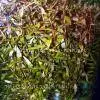Alternanthera reineckii
Scientific name: Alternanthera reineckii
Family: Amaranthaceae
Maximum size reached under cultivation: 25 - 50 cm (9.84 - 19.69 inch)
014
Recommended pH range: 6.2 - 7.1
Recommended water hardness: 4 - 12°dGH (71.43 - 214.29ppm)
0°C 32°F30°C 86°F
Recommended temperature range: 23 - 30 °C (73.4 - 86°F)
Preferred propagation method: Cuttings
Native to: South America
Growth rate: Slow
Recommended substrate: Fine gravel
Lighting requirements: Bright
Ideal placement in tank: Midground
Common Names
Magenta Water Hedge
🌍 Origin
Alternanthera reineckii originates from South America, especially the Amazon Basin, where it grows along flooded banks, in wetlands, and slow-moving rivers. It can thrive in both submerged and emersed conditions depending on seasonal changes, making it a resilient and adaptable aquatic plant.
🔎 Quick Overview
- 🌊 Ideal For: Aquariums, paludariums, ponds
- 🧑🌾 Difficulty Level: Medium
- 💨 CO2 Needs: Beneficial but not essential
🌱 Growing Conditions
Alternanthera reineckii grows best fully submerged in aquariums but can adapt to paludarium conditions when humidity is high. Bright lighting is critical to enhance its signature red and magenta hues and to avoid leaf drop in lower portions of the stem.
Use a nutrient-rich substrate like fine gravel or sand. Regularly supplement with iron and potassium using root tabs or liquid fertilizers. While CO2 injection is optional, it significantly boosts both growth rate and vibrancy under intense lighting.
🏞️ Planting Area
This plant fits well in the midground or background of aquariums. In smaller tanks, it can serve as a vibrant centerpiece. When planted in groups, it forms a striking, bushy appearance. Leave spacing between stems for better light and water circulation.
🔁 Propagation
Propagation is easy via stem cuttings. Trim a healthy stem just above a leaf node and replant it directly into the substrate. Ensure each cutting has several leaves. Frequent trimming promotes bushier growth and prevents the plant from becoming leggy.
🧪 Difficulty
Alternanthera reineckii is a moderately demanding species that rewards attentive aquarists with bold coloration and healthy form. It prefers stable water parameters, consistent nutrients, and intense light. Best for intermediate hobbyists or ambitious beginners who want to explore colorful aquascaping.
🌿 Short Description
This species is a standout stem plant prized for its deep red to magenta foliage. It grows slowly, making it ideal for Dutch-style and nature-style aquascapes where color contrast is desired. While capable of emersed growth, it reaches its full potential when submerged under high light and nutrient-rich conditions.
💡 Lighting Requirements
High light is essential. Under fluorescent lights, aim for 0.5–1 watt per liter (2–4 watts/gal) or 30–40 lumens/liter with LEDs. Provide 8–10 hours of light daily. In high-light tanks, CO2 enhances foliage density and pigmentation.
⚠️ Potential Issues
- 🟡 Yellow or Brown Leaves: Often caused by insufficient light or iron deficiency. Improve lighting and fertilization.
- 🐌 Poor Growth: Linked to lack of nutrients or CO2. Maintain stable conditions and dosing.
- 🍂 Lower Leaf Drop: A sign of inadequate light. Increase brightness and CO2 if needed.
- 🌡️ Temperature Sensitivity: Prefers water above 23 °C (73.4 °F). Cooler water slows growth.
🌟 Overall Appeal
Alternanthera reineckii is a favorite in the aquascaping world for its bold appearance and colorful accents. It suits a variety of layouts, from minimalist to heavily planted designs. With proper lighting and care, this plant becomes a vibrant, long-lasting feature in both beginner and expert aquariums.

 Alternanthera rosaefolia
Alternanthera rosaefolia Telanthera lilacina
Telanthera lilacina